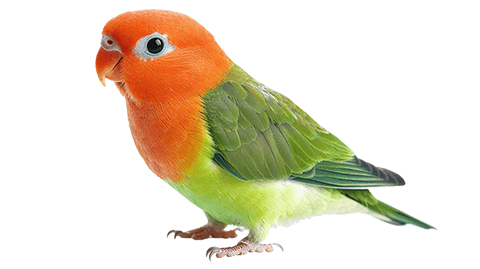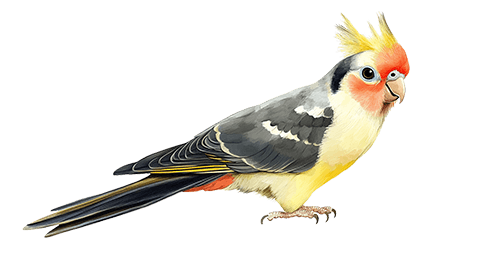Lovebirds: The Tiny Parrots with Big Personality

Lovebirds — they’re not just a romantic symbol, they’re also a feisty, colorful species of small parrots that are incredibly social and affectionate. Whether you’re a seasoned bird owner or someone who’s just curious, learning about these little creatures will definitely win you over.
What Lovebirds Do
Lovebirds are known for their energetic and playful behavior. You’ll often find them climbing around, exploring their environment, and chewing on just about anything they can get their beaks on. Toys are essential for lovebirds — without mental stimulation, they can get bored and may develop destructive behaviors. Puzzle toys, shreddable paper, and bird-safe wooden toys are some of their favorites.
They are incredibly social birds, both with their human caretakers and with other lovebirds. They get their name from the strong bond they form with a partner, spending hours preening each other, snuggling, and showing affection. But don’t be fooled — they can be just as happy living solo as long as they get enough attention from their humans.

What They Like
- Social Interaction — Lovebirds thrive on interaction. They are naturally curious and will often engage with their surroundings. They enjoy playing with toys, foraging for food, and even mimicking sounds they hear in the household (though they are not known to be great talkers like larger parrots).
- Affectionate Bonding — If you keep two lovebirds together, you’ll see their strong bond in action. They will sit side by side, preening each other and communicating with soft chirps. This behavior can also extend to their human companions if raised as a single bird. They’re quite happy to perch on your shoulder or cuddle close, but only if they trust you.
- Bath Time — Lovebirds love taking baths. A shallow dish of water will have them splashing around, fluffing their feathers in sheer joy. It’s both entertaining to watch and important for keeping their feathers in good condition.
- Chewing — These little parrots love to chew. From food to toys to anything wooden, they have an insatiable urge to nibble. Make sure to provide safe and engaging toys that satisfy their need to chew, or your furniture might become their next target!

Their Relationship with Humans
Lovebirds can develop very close bonds with humans, especially when hand-raised. A lovebird that has been properly socialized will be affectionate, curious, and eager to spend time with you. However, it’s important to know they can also be territorial and sometimes nippy, especially if they feel threatened or startled. With patience, training, and positive reinforcement, they can become wonderful companions.
They require daily attention — being left alone for long stretches can lead to loneliness and behavioral issues like excessive squawking or feather plucking. So, if you’re planning to have a lovebird, make sure you’re able to devote time to keeping them company.

Activity Level
Lovebirds are busy, busy birds! They’re always on the go — flying, climbing, playing, and exploring. You’ll need to provide plenty of opportunities for exercise, especially if they spend a lot of time in a cage. A large cage with multiple perches, ladders, and toys will help keep them physically and mentally stimulated.
Out-of-cage time is crucial for their well-being. Allowing them to stretch their wings and explore their surroundings (in a safe, supervised environment) is key to keeping them happy and healthy.

Interesting Facts About Different Kinds of Lovebirds
There are nine species of lovebirds, each with its own unique characteristics. Here are some interesting facts about a few of them:
- Peach-Faced Lovebird — These are the most common lovebirds kept as pets. They’re recognized by their peachy-pink face and green bodies. Despite their small size, they have big personalities — playful, mischievous, and full of energy.
- Fischer’s Lovebird — These lovebirds are smaller and have a beautiful color combination of green bodies, orange-red faces, and blue or purple on their tails. Fischer’s lovebirds are known for being a bit more shy and reserved than their peach-faced cousins, but they are still very affectionate once they warm up.
- Masked Lovebird — As their name suggests, these lovebirds have a striking black “mask” on their faces, paired with bright yellow and green feathers. They are a little more independent but still love to be social and playful.
- Abyssinian Lovebird — These are rarer in captivity and unique because the males and females have very different colors. Males are bright green with a red forehead, while females are a duller green with no red. They tend to be quieter and less demanding than other species, making them a good choice for those who want a more peaceful bird.

Final Thoughts on Lovebirds
Lovebirds are charming, intelligent, and full of personality. If you’re thinking of bringing one into your home, just remember — they require a lot of interaction, mental stimulation, and love to stay happy. Whether you have one or a pair, you’ll find they’re endlessly entertaining and a joy to care for. But be prepared — once you’ve had a lovebird, you may never want to be without one again!
Further reading: “The Lovebird: An Owner’s Guide to a Happy Healthy Pet” (Amazon affiliate link) by Pamela Leis Higdon.
Affiliate Disclosure
This post may contain affiliate links, which means I earn from purchases made through links. Please see the privacy policy page for more details.






